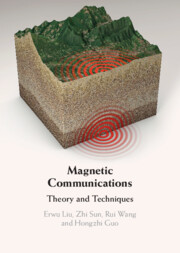Book contents
1 - Introduction
from Part I - Introduction and Properties of MI
Published online by Cambridge University Press: 04 January 2024
Summary
The so-called magnetic communication makes use of the time-varying magnetic field produced by the transmitting antenna, so that the receiving antenna receives the energy signal by mutual inductance. Research studies show that the penetrability of a magnetic communication system depends on the magnetic permeability of the medium. Because the magnetic permeability of the layer, rock, ice, soil, and ore bed is close to that of the air, channel conditions have less effects on magnetic transmission than electric transmission. Therefore, the communication network based on deep-penetrating MI can expand the perception ability and sensing range of information technology effectively, which can be applied to complex environments such as underground, underwater, tunnel, mountain, rock, ice, and forest. We conclude that the network construction of IoT based on magnetic communication is of great value and can be regarded as one of the reliable technologies to improve the connectivity of a wireless network.
- Type
- Chapter
- Information
- Magnetic CommunicationsTheory and Techniques, pp. 3 - 27Publisher: Cambridge University PressPrint publication year: 2024

